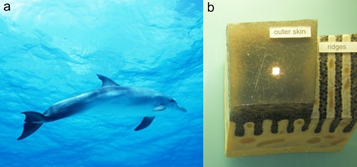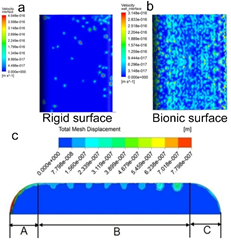Dolphin's special skin structure has characteristics of drag reduction. By mimicking this structure, a kind of bionic coupling functional surface which has practical engineering application value was designed. It was applied on the surface of a centrifugal pump impeller to investigate the efficiency enhancement of the pump through contrast experimental method. The experimental results showed that the pump efficiency was improved by 3% by using this kind of bionic coupling functional surface. The hardness of surface material had influence on the pump efficiency. The mechanism of efficiency enhancement of bionic coupling functional surface was the coupling deformation between elastic surface material and bionic structure on the basal material, which can decrease the drag of impeller surface, absorb some energy and effectively reduce the turbulent kinetic energy of the inlet and outlet of impeller. Thus, the hydraulic loss would be decreased.
Dolphins (Tursiops truncates) swim very fast, usually at 30-40 km/h. Some individuals can even swim at 55 km/h and can maintain a long time. Dolphin skin is mainly composed of smooth epidermis, dermis and muscular adipose layer, as shown in Figure 1. The special structure of its skin gives it high elasticity, which is also one of the main reasons for its dynamic control of the fluid medium to obtain drag reduction performance. As a warm-blooded animal, there is a temperature difference about 9℃ between the skin surface and the fluid boundary layer during high-speed swimming. While controlling the flow pattern through the elastic skin structure, the dynamic viscosity of the fluid boundary layer can be regulated by the temperature difference of the flexible wall as well, so as to achieve coordinated drag reduction.

Figure 1. Dolphin and it’s skin texture
Inspired by the dolphins and other warm-blooded animals, which use skin elasticity and body surface temperature to control fluid media to achieve drag reduction, a bionic surface with both elastic and thermal conductivity was constructed and prepared. Normally, the drag reduction characteristics of elastic materials are affected by their poor thermal conductivity. The functional surface can not only transfer the heat energy to the fluid medium in time to avoid the aging of the functional surface, but also achieve the purpose of controlling the fluid to achieve cooperative drag reduction through the wall temperature.
Using polyurethane to imitate the surface of dolphin skin and cast iron to imitate the dermis and muscles of dolphin skin, a heterogeneous layered bionic coupling functional surface was constructed. It was applied to the surface of centrifugal pump impeller and channel. The velocity gradient of the fluid boundary layer decreases, resulting in frictional force reduction (Figure 2). Then, the efficiency and drag reduction of pump were studied, and it obtained good drag reduction effect. The efficiency of the pump is increased by 3%~5%.

Figure 2. the velocity gradient of the fluid boundary layer decreases, resulting in frictional force reduction (a, b).
the bionic functional surface could control the wavelength of unstable wave to obtain drag reduction actively (c).
It can be used in ships, vehicles, pipelines, pumps and fans and other fluid machinery and equipment. Current applications include casting surface morphological structure on the impeller (a), coating surface material on the impeller (b), and the bionic pump (c). Among them, the efficiency of bionic pump is increased by 3%~5%.

Figure 3. Applications of bionic functional surface.
[1] Gray J. Studies in animal locomotion VI. The propulsive powers of the dolphin[J]. Journal of Experimental Biology, 1936, 13(2):192-199.
[2] Kramer M O. THE DOLPHINS' SECRET[J]. Journal of the American Society for Naval Engineers, 2009, 73(1):103-108.
[3] Pätzold A, Peltzer I, Nitsche W, et al. Active compliant wall for skin friction reduction[J]. International Journal of Heat & Fluid Flow, 2013, 44(3):87-94.1
[4] Endo T, Himeno R. Direct numerical simulation of turbulent flow over a compliant surface[J]. Journal of Turbulence, 2002, 3(3):1--10.
[5] Hampton I F, Whittow G C. Body temperature and heat exchange in the Hawaiian spinner dolphin, Stenella longirostris.[J]. Comparative Biochemistry & Physiology A Comparative Physiology, 1976, 55(2a):195-7.
[6] Mcginnis S M, Whittow G C, Ohata C A, et al. Body heat dissipation and conservation in two species of dolphins.[J]. Comparative Biochemistry & Physiology A Comparative Physiology, 1972, 43(2):417-23.
[7] Limei Tian, Yinci Wang, Haohua Gao, Zhen Shang, Luquan Ren. Study on control mechanism of surface fluid medium with mosaic bionic coupling function [J]. Journal of Agricultural Machinery. 2014 (06).
[8] Limei Tian, Zhihua Gao, Yinci Wang, Luquan Ren, Zheng Shang. Design and experiment of dual bionic coupling of morphological/flexible materials for efficiency and drag reduction [J]. Journal of Jilin University (Engineering Edition). 2013 (04).
[9] Vinod V S, Varghese S, Kuriakose B. Aluminium powder filled nitrile rubber composites:Effect of bonding agents[J]. Kautschuk Und Gummi Kunststoffe, 2004, 57(12):641-644.
[10] Jung-pyo Hong, Sungwoon Yoon, Taeseon Hwang, et al.High Thermal Coductivity Epoxy Composites with Bimoldal Distribution of Aluminum and Boron Fillers[J]. Thermochim-ica Acta, 2012,573:70-75.
[11] Kramer M. O., Boundary-layer stabilization by distributed damping[J]. Aeronaut. Sci.1957, 24(6): 459-460.
Luquan Ren
Limei Tian
Kramer M. O.
